SEO strategies are something you cannot just formulate, implement and rest. The industry is so volatile and unpredictable that every few days there are new updates and norms launched by Google requiring the whole strategy to be reframed so that the website can come in Google’s good books. Before the inception of Google algorithms the
SEO strategies are something you cannot just formulate, implement and rest. The industry is so volatile and unpredictable that every few days there are new updates and norms launched by Google requiring the whole strategy to be reframed so that the website can come in Google’s good books. Before the inception of Google algorithms the scenario was different, it was simple to have a high ranking on Google, but today its totally different and the keyword competition has gone to a totally different dimension which is why the industry has witnessed a phenomenal change in the past three years.
The popular illegitimate SEO practices are called ‘Black hat SEO’ practices, but they have been tried and tested and they failed miserably which is why the webmasters now know that Google is actually their big daddy and they can’t fool it with cheap and silly tricks. But as people are always on the lookout of shortcuts to success, another terminology has come to fore- “Negative SEO”
Negative SEO must not be confused with black hat SEO. It’s something totally different and every webmaster must understand it in order to save his business from being its victim. Let’s understand through this guide all about negative SEO and how to safe guard your brand from it.
- Definition
- Intensity of danger of Negative SEO
- How to build a shield against negative SEO assaults
- Tracking the back links profile of your website
- Safeguard your important and high quality back links
- Safeguard your website from the assault of malware and hackers
- A summary of what you must do in times of victimisation of negative SEO conspiracy
Definition
Negative SEO is the use of black hat SEO techniques not to enhance one’s own ranking in the search engine results rather jeopardise the search engine ranking of competitors. It’s a form of use of black hat SEO techniques to cause harm to the image of the competitor’s website. It can be done in the following ways:
- Hacking a website.
- Constructing a large number of spammy links linking to a website.
- Copy pasting the content of a website and sharing it on the web liberally.
- Referring to a website by pointing toward it with the use of keywords like poker online, Viagra etc.
- Elimination of the high quality backlinks present on a website by a competitor.
Intensity of danger of Negative SEO
Is Negative SEO a Real Threat?
Without a doubt it is. There are live examples present that reflect the success of negative SEO on websites. Negative SEO can literally shatter the ranking as well as reputation of a website. The disavow tool of Google was specifically launched keeping in view this very problem. Taking care of the problem is very difficult so rather prevent it from happening. This disavow tool is recommended by Google to be used as the last resort only. The negative SEO industry is actually flourishing and a large number people are willing to do negative SEO at a minor payment of $5. The forums of black hat SEO practices also have a lot of stories to tell, when it comes to how they successfully damaged a websites search engine ranking using negative SEO.
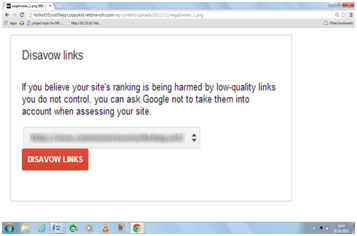



Matt Cutts says that Google takes around 15 days to a month to bring in consideration the disavow link request sent through the Google’s disavow tool, but seriously which webmaster can happily bear this burden? Penalty by Google on your website for one whole month is simply unaffordable and not feasible at all. It’s not a solution, but surrender to negative SEO tricks implemented by your competitors. Let me help you deal with them and safe guard your brand and business from the attacks of negative SEO by your competitors.
How to build a shield against negative SEO assaults
Activating the email alerts by Google webmaster– Google sends notifications to websites in several cases of threats:
- Malware assault on your website
- In case some of your web pages are not indexed on Google
- In case your website has issues with connectivity of server
- In case your website is being penalised by Google
It’s a mistake to not connect a website with Google Webmaster tools because they are at your service. If you haven’t connected your website with them yet, its time you should. It’s very simple. The image below will guide you on how to do it. Once you activate it, the first phase is crossed but it’s the most basic one. Next is tracking the back links profile.
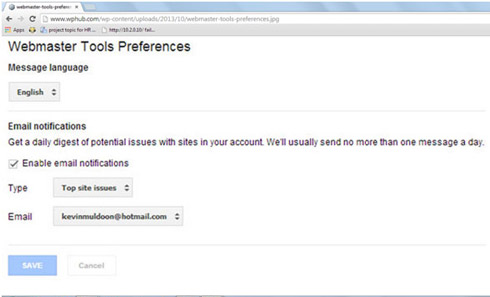

Tracking the back links profile of your website
Tracking back links profile is the most important step to deal with negative SEO as it help in dealing with spammers. The very first conspiracy spammers plot is they create unnatural and cheap quality links as well as low quality redirects to your website. There are end number of tools available like Ahrefs, open site explorer etc. that can be used frequently to detect the unnatural link construction to your website. The best one among the lot is monitorbacklinks.com. It’s a simple and very convenient tool that gives you notifications whenever your website gets or loses a relevant back link. It doesn’t just help you by tracking your back links every day rather it sends the detailed relevant information direct to your inbox. You need to create an account, include it in your domain and sync it with your Google analytics account. Majorly it helps in detecting the back links at once, though sometimes it might take a while. The settings are set by default as such that you receive notifications whenever a new back link is received by your website.
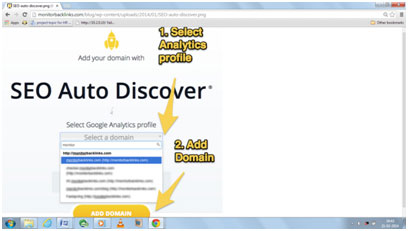

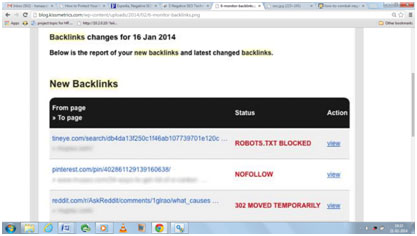

Safeguard your important and high quality back links
That’s the harshest weapon used by the spammers when they delete the best of your backlinks. What they do is, they come in touch with the person that owns the link forging your identity and get it deleted. How to stop them from doing it?
Always communicate with the link owners using email ID originating from your own domain instead of using Yahoo, outlook or Gmail. This authenticates your identity and makes clear that it’s not someone else forging your name. Attach the name of the representative responsible for communication with website owners with the name of your domain- [email protected]. It must look something like this, so that the link owner doesn’t get tricked.
Track the ranking of your back links in order to detect which ones are your cash cows. Monitorbacklinks.com can help you with the same. With its help you can add captions and tags to the back links that are important and you don’t want to lose. With the help of these tags you can find these backlinks later easily. Just click on the backlink, select edit and create a list of them, filter them and keep a track of their status. Just in case you notice a modification in the status, contact the link owner immediately to know the reason of the backlink removal from your website.
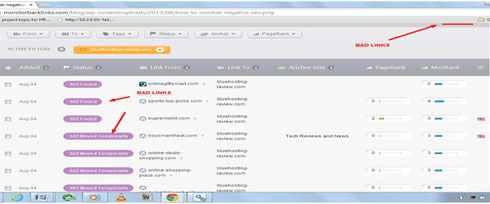

Safeguard your website from the assault of malware and hackers
Having spam on your website is a nightmare come true. It’s something you wish never to happen to your website. How to safeguard your website from them:
- WordPress users can use the Google authenticator plugin which helps in developing the security mechanism by a two step password verification process. It requires entering a code assigned by Google authenticator on ios and android smart phones.
- Unique password must be set which should be a combination of numbers, letters and characters.
- Regular back up of files as well as database must be made
- If you give users autonomy to upload files to your website, contact the hosting company of your website to activate the antivirus so that you can safeguard your website from malware.


Keep in check duplication of content- Another very brutal technique used by spammers to do negative SEO is to circulate your content on the web by copying it. This makes your website prone to Google penalties which lower its ranking. Copyscape.com is a brilliant tool to tackle the issue. All you need to do is to add the content or whole website to it and it will tell you whether the content of your website is present anywhere else on the web without your knowledge and approval.
Keep a check on social media presence of your website- Social media is an awesome platform for SEO in fact I call it a blessing for SEO industry. It’s a brilliant platform, but it can easily take shape of your ugliest reality. What spammers do is they create accounts in the name of your website and misuse them. These kinds of fake accounts must be removed ASAP by filing reports against them before they gain followers. Mention.net is a good tool to detect the culprit using your name through such accounts. This tool helps by notifying a website immediately if its name is mentioned anywhere on the social media platform. All you need to do is to make an account on it and click on create alert. Name the alert you wish to create as well as mention the specific keywords you need alerts on. Go to the next step and click on ‘choose the resources’ you want this tool to detect for you as well as include the domains you wish to avoid. Select ‘create my alert’ and get all alerts about mention of your keywords anywhere on the social media platform.
Speed of your website tells you about spam attack- If your website is experiencing long time in getting loaded, its reason might be because some spammer is sending large number requests to the server of your website to slow it down. This needs to be addressed very quickly because its severe form can even shut down the server of your website. The tool that comes of help in situation like this is pingdom.com. It’s a really nice tool and helps nicely to track the loading time as well uptime of your server. Its usage is very simple. All you need to do is sign up for it and create alerts for email to know whenever your server goes down. In case you detect an assault, consult the hosting company of your website immediately to help check on the issue and help you deal with it.
There might be loopholes present in your own SEO strategies- There are times when you will realise that you were just beating around the bush and you were doing your own negative SEO. It’s the SEO techniques you use sometimes that let you down because they are not in conformity with Google’s criteria. Some of them are-
- Linking to the websites that are facing penalty from Google
- Inorganic links for SEO are a big no-no. If you feel that links bought from the blog networks work, you are misguided
- Guest posts are helpful for SEO, but it doesn’t mean that you have to publish all of them no matter they are quality or low quality. Publish your guest posts very cautiously.
- Money keywords are safe to be used but don’t make a lot of backlinks based just on them. Make sure that more than half of the anchor text used must have the name of your website.
- “Nofollow” attribute is something that must be used if you are selling links on your website as it discourages spam.
Never declare a war online-Online space is different than physical as it doesn’t let you know who is behind the enemy lines. Competitors use the dirtiest of trick to outrun competition online and you never know whether the person you are declaring war with is a spammer or just a customer or client. Spammers sometimes do negative SEO out of fun, or for the sake of taking revenge or just to beat your website in the search engine rankings.
A summary of what you must do in times of victimisation of negative SEO conspiracy
1. List down the backlinks you should eliminate- Classify the recently created links into good and bad. Tag the bad ones, keep a frequent check on them and decide which of those are hurting your search engine ranking. Once they are detected, remove them. It is advisable that this list must be made at once after you receive the email alert on new backlinks that look like spam.
2. Efforts for removal of backlinks- Once the bad backlinks are detected get in touch with the website owner and file a request for link removal. Whois.com is a fine website to know the contact information of webmasters in case you face problem finding it. If your request of link removal is not considered by the website owner, find out the information about the company that’s hosting it and request them to eliminate the spammy links. They help mostly. To acquire such information whoishostingthis.com can be helpful.
3. Disavow list, the last resort- If none of the above mentioned techniques work to get rid of spammy links, prepare a Google disavow list in the form of a file and submit it to Google webmaster tools. Monitor backlinks.com will help you in creating the list of links you should request Google to disavow.
I hope this will be helpful to all the webmasters who are victims of negative SEO. Negative SEO cannot be dealt with instantly. Even when you use different quicker tools other than Google disavow, you need to be patient and calm because decisions made in haste are always ghastly.

